Contents
Grape diseases appear most often against the background of a lack of nutrients and improper care. To prevent or cure ailments, you need to study their symptoms and features.
What are the diseases of grapes
Diseases of grapes can be divided into two main groups:
- Infectious. This category includes ailments arising from infection with fungal spores or viruses.
- Non-infectious. Such diseases develop on poor soils or due to violation of the rules of care, the plant’s endurance decreases and yields deteriorate.
Infectious diseases are more dangerous because they are difficult to treat and can completely destroy plantings. To eliminate non-communicable diseases, it is usually enough to reconsider the approach to agricultural technology.
Fungal diseases of grapes
Most often, grapes suffer from infections caused by pathogenic fungi. Diseases usually develop on acidic and waterlogged soils.
Mildew
Among the main diseases of grapes, mildew, or downy mildew, can be noted, which is activated in spring at temperatures above 10 ° C. Manifested by oily light yellow spots on the leaves, over time they turn into a dry coating on the underside of the plates. A neglected disease can also affect ripening fruits.
In the early stages, mildew can really be cured by spraying with fungicides. It is recommended to use Antracol, Profit Gold and Ridomil in accordance with the instructions.

Regular weeding of the site and mulching of the soil helps to avoid mildew infection.
Oidium or grape powdery mildew
Oidium, or powdery mildew, is a fungal disease that leaves a grayish dry coating on the plant plates. Over time, spots spread to inflorescences and fruit clusters, small berries quickly die, and large ones crack and begin to rot. The leaves are deformed and become curly. The grape disease appears in the summer, usually in warm, damp weather.
You can cope with the disease with the help of drugs Thanos, Horus and Topaz. To prevent the disease, it is recommended to regularly thin out the plantings, tie the vine to the trellis and loosen the aisles.
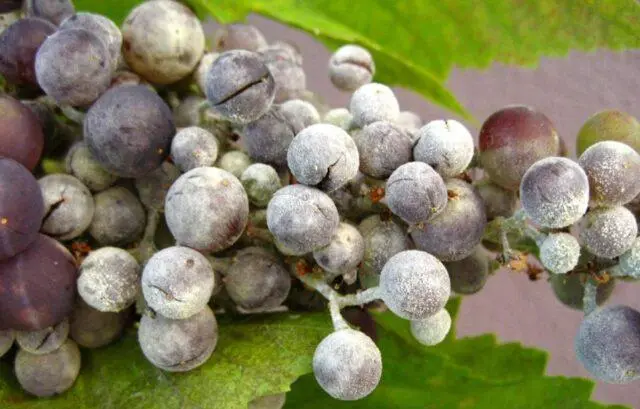
Especially often grape bushes suffer from oidium, for which regular pruning is not carried out.
Antraknoz
A dangerous fungus infects the leaves and shoots of grapes. First, brown spots appear on the infected areas, and then the vine begins to crack and gradually dies off. Dark dots appear on the berries with a black border.
It is recommended to treat grapes for the disease with drugs Acrobat, Horus and Ridomil. For prevention, it is useful to use Bordeaux liquid. Grapes are sprayed on the leaves at intervals of 1-2 weeks.
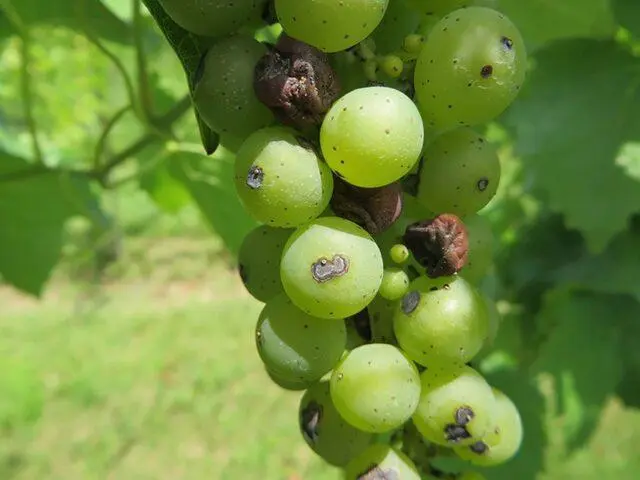
The fungus that causes anthracnose overwinters on the affected organs of grapes and can remain active for up to five years.
Alternaria
Fungal disease affects the green vine and berries. It appears as brownish spots on the leaves with necrotic areas in the center, over time the plates darken and become moldy. Fruits with alternariosis are first covered with a shiny film, and then acquire a brown-gray coating. The harvest becomes unusable.
It is necessary to fight the disease of grapes from early spring and throughout the season. Bushes are sprayed with Quadris and Skor, as well as Bordeaux mixture. For prevention, it is necessary to carry out a sanitary cutting of plantings annually and in the fall to remove all plant debris from the site.
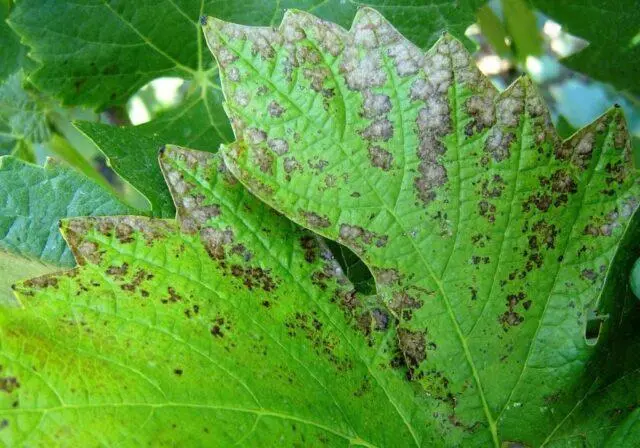
Alternariosis develops in conditions of heat and high humidity.
Black spot (Phomopsis)
Fungal disease leads to the appearance of reddish spots on the shoots and leaves, over time the marks darken, and then discolor. The berries are colored and deformed, and then fall off the brush when touched by the comb. Against the background of black spot, the yield is greatly reduced.
The disease is difficult to treat, therefore it is recommended to spray the plantings with Bordeaux liquid prophylactically and prevent the appearance of the fungus. If phomopsis nevertheless developed, severely affected plants are removed from the site, and the remaining ones are treated with Skor, Horus or Topaz preparations according to the instructions.
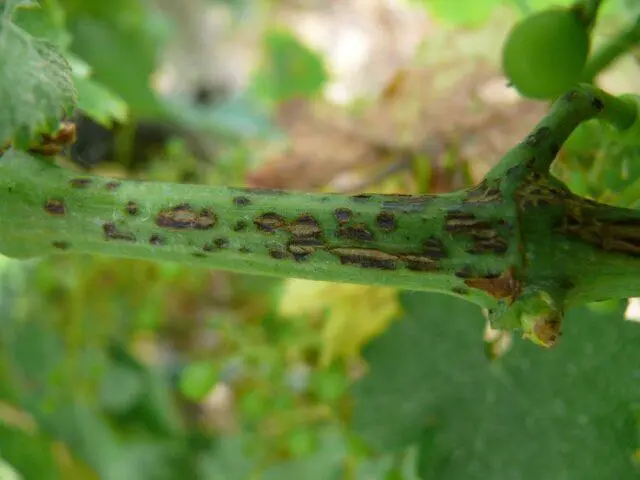
Phomopsis infects grapes during the flowering period, but the first symptoms usually appear only by August
Gray mold
Gray rot develops on young buds and shoots and quickly affects all annual branches and green leaves. Leaves a plaque on the underside of the plates, on inflorescences and fruit clusters. A grape bush, when strongly affected by the disease, seems to release a cloud of dust from touch. Gradually, the affected areas of the plant darken and dry out.
Topaz and Horus preparations become good means of protecting grapes from disease. To prevent the disease, it is important to prevent waterlogging of the soil, since the fungus usually manifests itself in cold and rainy weather.
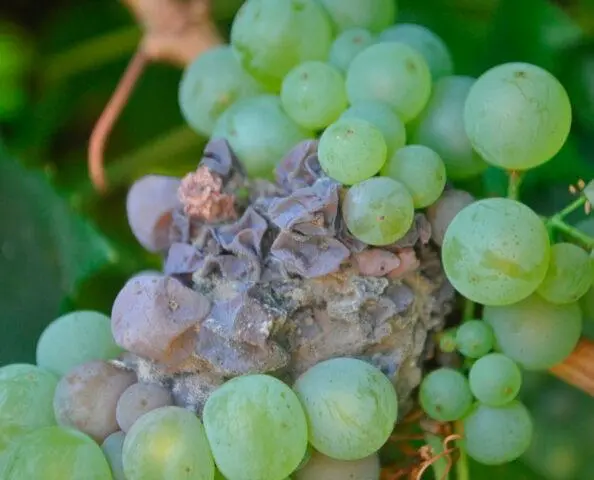
Grapes especially often suffer from gray rot after inaccurate grafting.
Black rot
With black rot, light brown spots appear on the leaves with a dark rim and dots in the center. Berries suffer from disease in the middle of ripening. First, a white spot appears on the skin, and then a brownish ring forms around it. Within ten days, the fruit dries up and turns into a dry black mummy stuffed with fungal spores.
In the early stages, rot can be cured with Ditan, Strobi and Polyram. Heavily affected bushes are best removed from the site in order to preserve neighboring plants, since the fungus quickly spreads from diseased specimens to healthy ones.
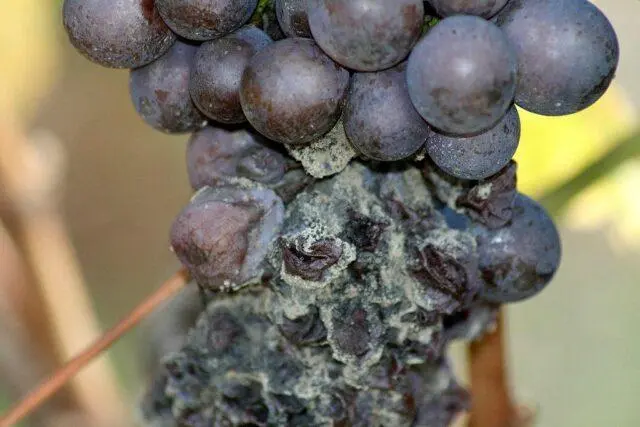
During the first five weeks after flowering, grapes are immune to black rot.
White rot
A grape disease in autumn or late summer attacks half-ripe fruits. At first, small pink spots appear on them, but after a few hours, the infected berries shrivel and darken. Especially often, varieties with thin skin and juicy pulp suffer from the disease, the infection quickly spreads through the bunch, and a characteristic smell of rot appears.
If the disease is affected, the affected brushes are removed and urgent treatment is carried out with Fundazol or Bordeaux liquid. Preventive spraying is recommended in hot weather and in case of mechanical damage to the fruit.
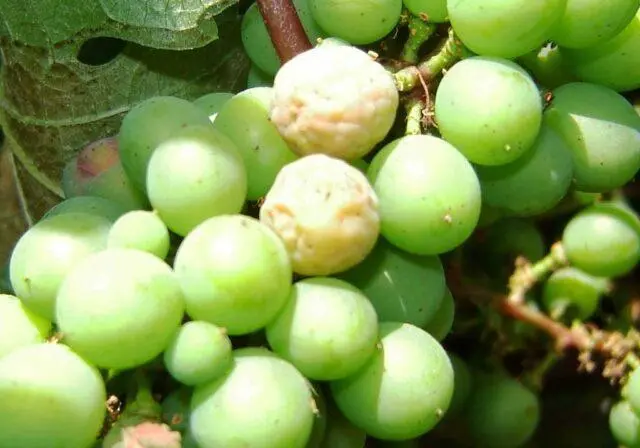
White rot most often develops on grapes against the background of a sunburn.
Cerkosporoz
Fungal disease is manifested by olive bloom and dark spots on the underside of the leaves. Ripening berries shrivel and harden, the quality of the crop and its volumes fall sharply. If left untreated, the affected parts of the grapes die off. The disease develops most quickly at a temperature of about 30 degrees and in low light.
For the treatment of cercosporosis, Bordeaux liquid and systemic fungicides are used. Severely weakened plants are removed from the site.
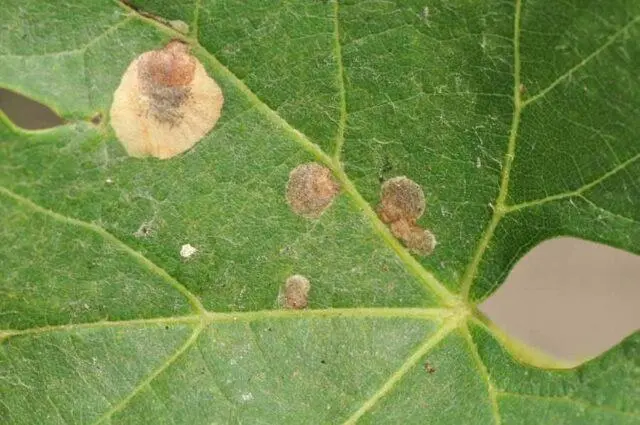
Cercosporosis usually affects old or weakened grapes.
Verticillosis
Verticillium, or wilt, infects grapes in early summer and leads to lethargy and discoloration of the shoots. Gradually, the branches die off, while spots similar to burns appear on the edges of the leaves. The disease spreads from the bottom up. Berries with verticillosis dry up and mummify, although they can be kept on the bushes for a long time.
There are no reliable ways to treat grape disease, so the affected plants are simply drastically cut off. The most effective prevention of the disease is to till the soil before planting the bushes. Usually wilt passes to grapes from infected soil.

Verticillium fungus can survive up to ten years in soil and plant debris.
Viral diseases of grapes
Viruses do not affect grapes as often as fungi, but are considered more dangerous. It is almost impossible to cure the affected plants, usually the bushes are either completely eliminated or healthy parts are used for reproduction.
Mosaic yellow
Mosaic usually appears in the spring immediately after the leaves bloom. The leaves of the plant turn yellow. In summer, the disease of the grapes may recede a little, and the natural green color will partially recover, but this will not mean recovery. In some cases, the leaves are deformed, and double shortened internodes appear on the shoots, but this does not happen with all varieties.
Viral mosaic leads to the gradual degeneration of the vine, reduced yields and infertility of grapes. The disease cannot be cured, therefore, usually the bushes are eliminated, having previously removed healthy apical shoots for further reproduction.
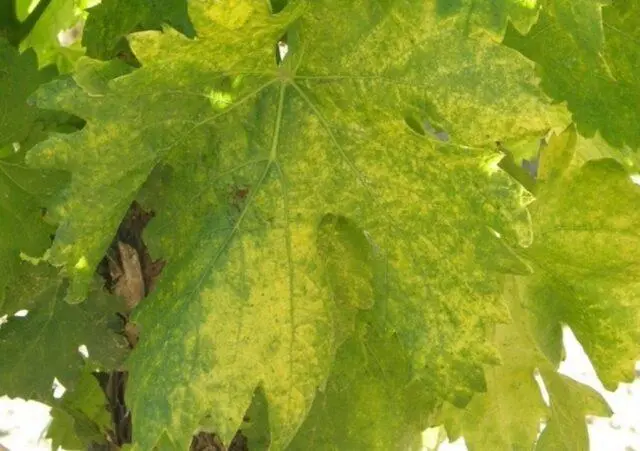
Yellowness with a mosaic of grapes can cover the entire leaf or appear in spots
Bordering of veins
A viral disease infects grapes when grafted or through the soil. Symptoms of the disease are golden spots on adult leaves or yellowing of the veins, and buds may dry out and fall off during the flowering period. The harm from a viral disease is that the grapes set fruits worse, the yield is reduced by up to 50%.
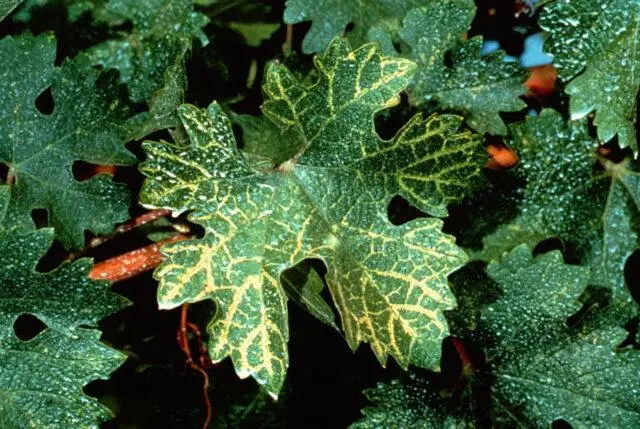
The banding of the veins is not treatable, the affected grapes must be destroyed
Viral infectious chlorosis
Infectious chlorosis of grapes forms characteristic yellow spots and stripes on the leaves in early summer. It does not cause direct damage to the berries, however, as the disease develops, the bushes begin to bear fruit worse, the crop becomes smaller and decreases in volume. Since the virus cannot be treated, infected grapes are destroyed.

Viral chlorosis most often appears on grapes after vaccination
Short knot
Grape disease can be recognized by linear or heart-shaped patterns on the leaves, shredding and curling of the plates, as well as greasy spots with an unpleasant odor. The reason is a viral infection of the roots – the plant does not receive enough nutrients. The berries become small, do not ripen to the end and crumble prematurely. As with most viruses, the only way to deal with short knots is to destroy infected bushes.
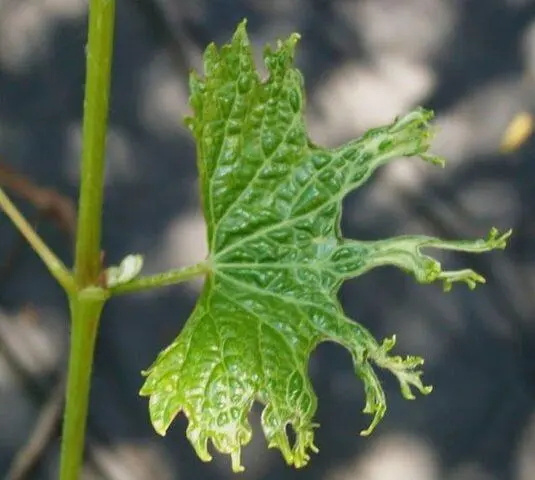
When damaged by a short knot, the grapes additionally suffer from insects due to the appearance of a sticky coating.
Necrosis
A viral infection affects the vessels of grapes and disrupts nutrition processes. The leaves of the plant turn white and die, gradually the bush begins to rot and dies. When affected by necrosis, the grapes are radically cut off or completely removed from the site and burned.
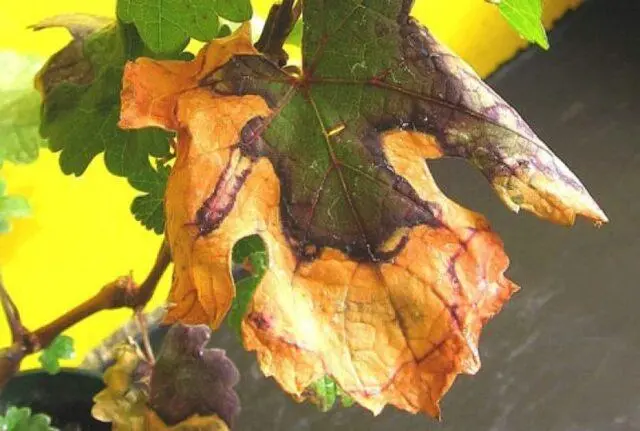
Necrosis disrupts the processes of photosynthesis in the leaves and shoots of grapes
Bacterial diseases of grapes
In accordance with the name, bacterial ailments of grapes are provoked by the ingress of bacteria into the tissues of the bush. Usually, diseases develop against the background of fungi or with mechanical damage to the fruits, shoots and root system.
Oleiron’s disease
With Oleiron’s disease, black spots appear on the leaves and shoots. The knots of the grapes become brittle, the buds become deformed, and the buds darken. The development of the shrub slows down, the yield drops.
In the first stages of the disease, sulfur preparations and Bordeaux liquid 5% can be used. A neglected bacterial infection requires the complete destruction of the bush.

Oleiron’s disease develops in cold rainy weather and against the background of late frosts.
Bacterial cancer
Grapes suffer from bacterial cancer with a decrease in immunity and after winter freezing of shoots. You can recognize the disease by the formation of tubercles on the branches, a decrease in the number of ovaries and drying of the leaves along the edges. As the disease progresses, photosynthesis processes are disrupted, and the grapes stop developing.
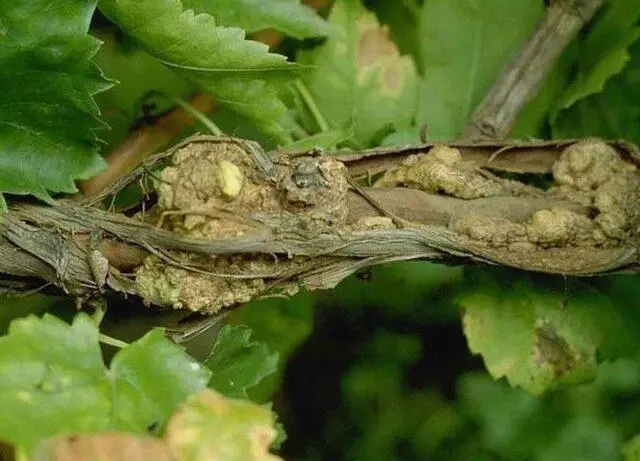
In the early stages, bacterial cancer can be dealt with with the help of Phytoplasmin and Phytoflavin.
Bacteriosis of berries
Among grape diseases in July, bacteriosis is of particular danger. It develops during the formation of the ovaries and manifests itself as yellow spots on the fruits, which gradually turn into brown-purple dents. The pulp dries out, in just a week the crop becomes unusable.
Most often, bacteriosis occurs when growing grapes under the bright sun. It is impossible to cure the affected fruits, but the disease can be prevented by providing the bushes with shelter from direct ultraviolet rays.
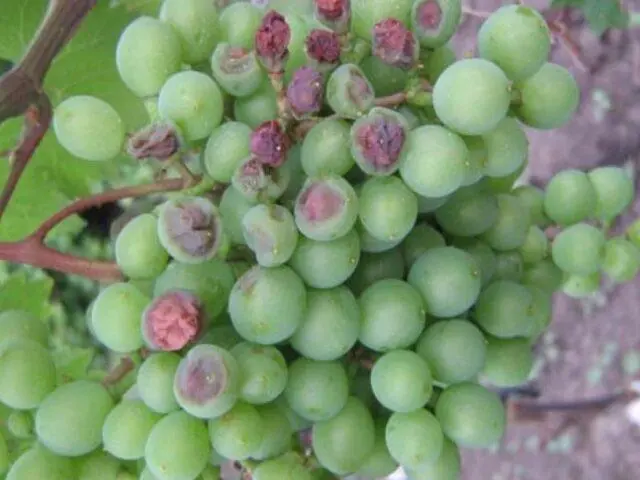
As part of the prevention of bacteriosis, it is necessary to prevent mechanical damage to the berries
Diseases of a non-infectious nature
Hot or too humid weather, lack of water and nutrients in the soil, freezing and sunburn lead to a deterioration in the health of grapes. There are several of the most common non-communicable diseases.
Chlorosis
Chlorosis develops against the background of a lack of iron, boron, zinc or manganese. It is expressed in yellowing of the leaf plates between the veins, the shoots of the plant become brittle, flowering stops. You can get rid of the problem by fertilizing with ferrous sulfate and complex minerals containing basic trace elements.
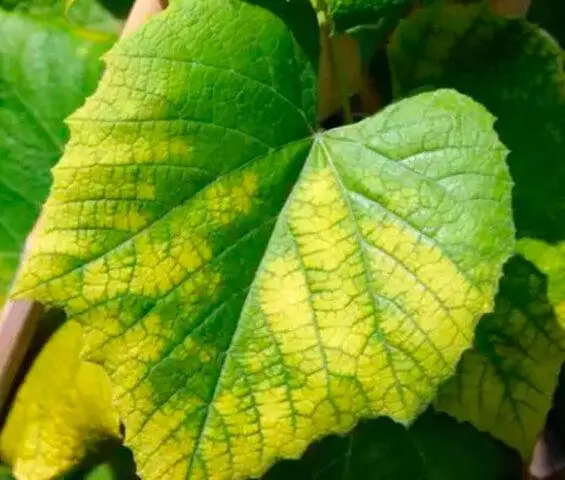
Chlorosis develops when excessive nitrogen is applied to the soil
Comb shrinkage
You can recognize the disease by dehydration and drying of the crest of the fruit brush. Berries against the background of the disease develop worse and become smaller, do not ripen to the end. The disease appears due to rare fertilizing and a deficiency of potassium and magnesium in the soil.

It is necessary to add potassium to prevent the crest from drying out, especially often in rainy weather.
Falling ovary
The ovaries crumble before the formation of berries against the background of overfeeding with nitrogen, with a lack of moisture and in the absence of pruning of the bushes. Grapes do not have enough nutrients for high-quality fruiting, or all resources are directed exclusively to building leaves and shoots.
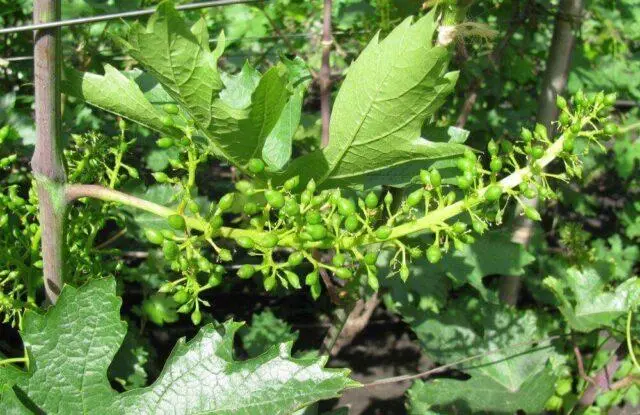
When shedding the ovary, you need to reconsider the approach to irrigation and add potassium-phosphorus top dressing
Prevention of grape diseases
Diseases of grapes and the fight against them cause a lot of trouble. It is easier to prevent the occurrence of ailments than to save landings. To prevent diseases it is necessary:
- choose zoned hardy varieties for a particular region;
- plant grapes in well-lit areas;
- prevent drying or waterlogging of the soil at the roots of the plant;
- regularly feed the grapes and carry out preventive treatments with fungicidal preparations;
- thin out plantings, avoiding thickening;
- annually perform preventive pruning and remove weak dry vines.
In winter, it is important for grapes to provide good shelter to prevent shoots from freezing. Before planting new bushes on the site, the soil must be thoroughly disinfected from possible fungi and pests.
Conclusion
Diseases of grapes can cause serious damage to the crop and lead to the complete death of individual plants. It is recommended to pay special attention to the prevention of fungi and viruses, since treatment is associated with significant difficulties.









